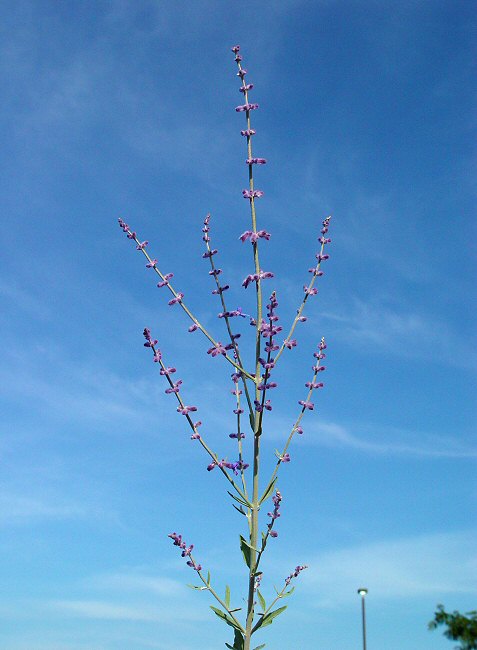Perovskia atriplicifolia Benth.
Russian Sage

Introduced
CC = n/a
CW =
MOC = 0
© DETenaglia
Perovskia atriplicifolia Benth.Russian Sage | |
 |
Introduced CC = n/a CW = MOC = 0 |
© DETenaglia |
|
Family - Lamiaceae Stems - To -2m tall, herbaceous, erect, 4-angled(the angles rounded), multiple from base, branching above, very mealy due to dense stellate scales. Fragrant if crushed.
Leaves - Opposite, decussate, petiolate below, sessile above, pinnatifid to bipinnatifid, ovate to broadly lanceolate in outline, to 10cm long, +4cm broad, glandular, mealy with minute stellate scales(more so below). Blade tissue tapering to base of petiole(cuneate).
Inflorescence - Terminal dichotomously branching paniculiform arrangement of long spikes. Verticillasters evenly spaced, +/-8 flowers per node. Flowers on short pedicels to 1.5mm long. Pedicels lanate, purple.
Flowers - Corolla bilabiate. Lips blue-purple. Upper lip 4-lobed, 7-8mm broad, 5mm long, with short branching pubescence externally, whitish at throat with violet lines. Lobes rounded, two lateral lobes longer than two central lobes. Lower lip single, 5mm long, 3.5-4mm broad, short branching pubescent externally, glabrous internally. Corolla tube 6mm long, blue-purple, typically glabrous but also pubescent near apex. Stamens 2, adnate near apex of corolla tube. Filaments lilac, 1.5mm long. Anthers purplish, .8mm broad. Nectaries at base of filaments. Style 1, 1.2cm long, glabrous, lilac, exserted. Stigma 2-lobed. Ovary of 4 nutlets. Nutlets glabrous, green-purple, .5mm long(in flower). Calyx tube lanate with branching pubescence, 5mm long, bilabiate, purplish, 8-nerved, glabrous and green internally.
Flowering - June - September. Habitat - Cultivated but prefers dry soils. Origin - Native to Eurasia. Other info. - This is a very popular plant in cultivation because it is very showy and tolerates neglect and dry soils. There are many cultivars of the plant which vary mainly in size. The blue-purple flowers are a big favorite of insects, especially bees. The light color of the corolla throat is like a runway for insects, guiding them to the pollen of the plant and the nectar at the base of the floral tube. Photographs taken in Poplar Bluff, MO., 6-26-04. |